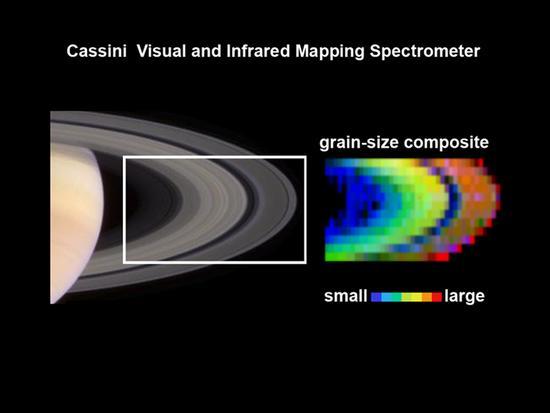The Stuff of Rings

| PIA Number | PIA06349 |
|---|---|
| Language |
|
The Stuff of Rings July 2, 2004 | |
Evidence from the visual and infrared mapping spectrometer on the Cassini spacecraft indicates that the grain sizes in Saturn's rings grade from smaller to larger, related to distance from Saturn. Those data (right) are shown next to a corresponding picture of the rings taken by Cassini's narrow angle camera. | |
This visual and infrared mapping spectrometer has a spatial resolution similar to that of the human eye, so it provides a view analogous to standing on the spacecraft. Only instead of looking at the rings in visible wavelengths, the instrument sees wavelengths beyond what human eyes can see, ranging from the ultraviolet to the infrared.
The latest observations show that grain sizes range from very small, like powdery snow on Earth, to larger grains, like more granular snow.
The visual and infrared mapping spectrometer can also see the fingerprint signatures of chemical bonds, and, in this case, it spotted the bonds of frozen water molecules. Saturn's rings are made mostly of water in the form of ice. While this has been known for many years, the Cassini data are showing that the ring ice is more pure than previously thought, with the most pure ices generally being observed at increasing distances from Saturn.
The Cassini-Huygens mission is a cooperative project of NASA, the European Space Agency and the Italian Space Agency. The Jet Propulsion Laboratory, a division of the California Institute of Technology in Pasadena, manages the Cassini-Huygens mission for NASA's Office of Space Science, Washington, D.C. The Cassini orbiter was designed, developed and assembled at JPL. The visual and infrared mapping spectrometer team is based at the University of Arizona, Tucson, Ariz.
For more information about the Cassini-Huygens mission, visit http://saturn.jpl.nasa.gov . For more information about the visual and infrared mapping spectrometer visit http://wwwvims.lpl.arizona.edu.
Image Credit:
NASA/JPL/University of Arizona
